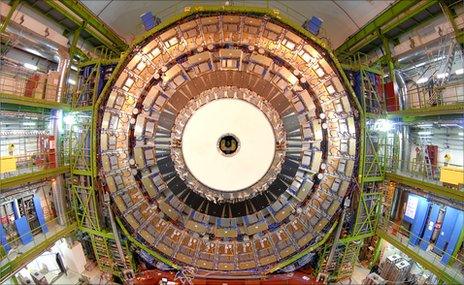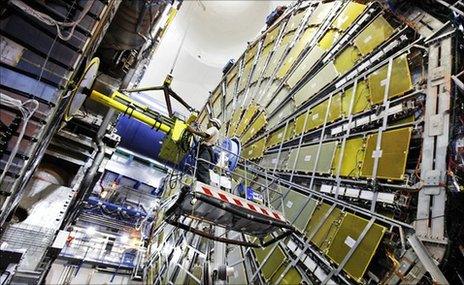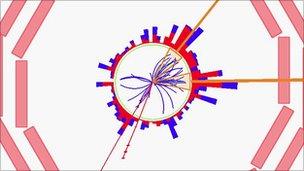LHC closes in on massive particle
- Published

CMS is one of two "multi-purpose" experiments housed at the LHC
Physicists at the Large Hadron Collider (LHC) have seen several candidates for the heaviest elementary particle known to science.
If the observations are confirmed, it would be a first for Europe; so far, the top quark particle has only been generated by one lab in the US.
Dr Arnaud Lucotte said the discovery could assist physicists in the hunt for the elusive Higgs boson, or "God particle".
Details of the top quark candidates were presented at a major particle physics conference in Paris.
The International Conference on High Energy Physics (ICHEP) runs from 22-28 July.
The Large Hadron Collider is operated by the European Organization for Nuclear Research (Cern), based in Geneva.
The LHC is a giant accelerator machine housed in a 27km-long (17 miles) tunnel under the French-Swiss border.
Two beams of proton particles are fired around the giant subterranean "ring" and smashed together at crossing points located around the tunnel.
Giant experiments are located at these crossing points to look for new particles in the sub-atomic wreckage of the collisions.
'Striking event'
Several possible detections of top quarks have been made recently by the LHC's Atlas and Compact Muon Solenoid (CMS) experiments.
Atlas has seen nine collision events compatible with the top quark; CMS has observed 3-4 candidate events. But physicists stressed that more data was needed in order to support the conclusive observation of top quark production at the LHC.
The detection of the top quark would represent a small milestone for the European lab, which is making steady progress after the accident which forced it to shut down for 14 months shortly after its "switch on" in 2008.

The Atlas detector has seen nine candidates for the top quark
And top quark physics is not well explained; studying it presents the opportunity to carry out important scientific work at the LHC.
The top quark was first discovered in 1995 by the Tevatron accelerator, operated by Fermilab in Illinois. Since then, the US accelerator has produced the particles in abundance. But they have never been produced outside Fermilab.
In a presentation at ICHEP, particle physicist Tim Christiansen said events observed by the CMS experiment included one "striking" top quark candidate.
Dr Arnaud Lucotte, from the French National Centre of Scientific Research (CNRS) told BBC News that the top quark was "well coupled" to the Higgs boson. In other words, there is thought to be a special interaction between these two particles.
Hunting the Higgs
Despite decades trying, particle physicists have so far failed to detect the Higgs. The boson particle is crucial to the current theory which has been devised to explain the interactions of sub-atomic particles, known as the Standard Model.
But rival physicists working at the Tevatron machine now believe the Higgs is within reach of the US accelerator.
They now hope to detect the elusive particle themselves, especially if the Tevatron's lifetime can be extended by three years until 2014, as is currently being discussed.

CMS saw a potential top quark "decay" into two other particles
If the Higgs boson exists in a form known as the charged Higgs, Dr Lucotte explained, the top quark could be crucial to detecting it.
Elementary particles generated at colliders "decay", or transform, into other sub-atomic particles, which may or may not be stable.
The close coupling of the charged Higgs to the top quark means that, if the Higgs boson is heavier than the top quark, it might reveal itself by decaying into a top quark and another particle known as a b-quark.
If the Higgs is lighter, then the top quark might decay into a Higgs and a b-quark.
Other physicists envisage a different type of Higgs, one which fits the constraints of the Standard Model.
The top quark might also act as the progenitor for so-called "supersymmetric" particles. These would represent an entirely new class of particles, predicted to exist by theorists, but which have yet to be observed at particle accelerators.
- Published22 July 2010
- Published22 July 2010
- Published14 July 2010